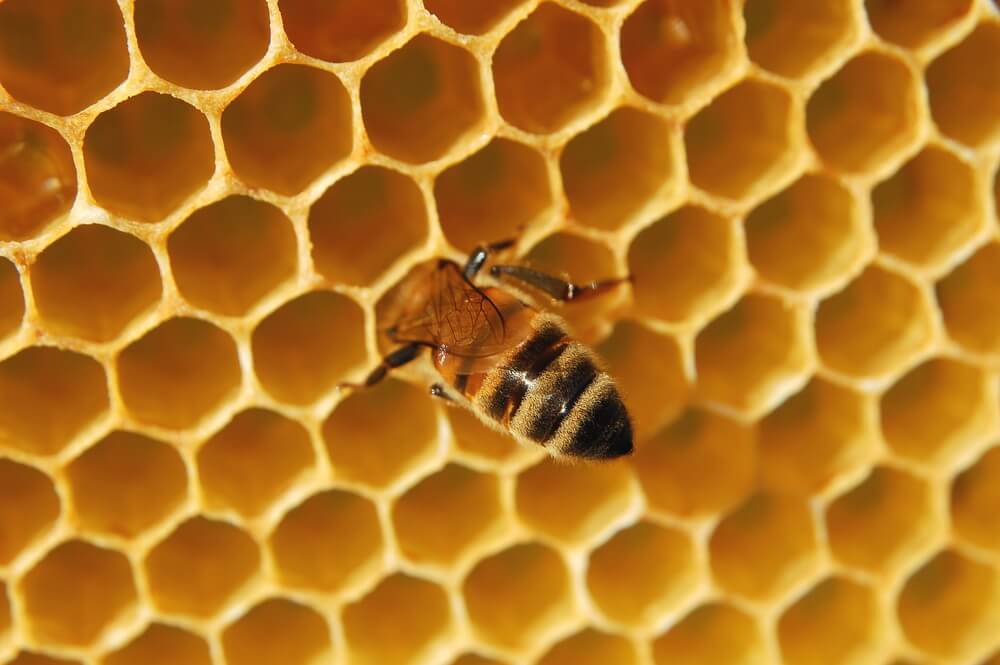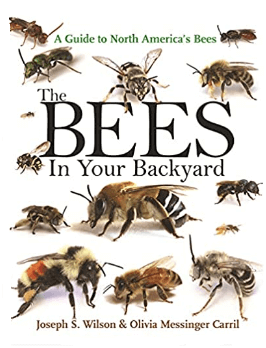Table of Contents:
What Do Honey Bees Look Like?
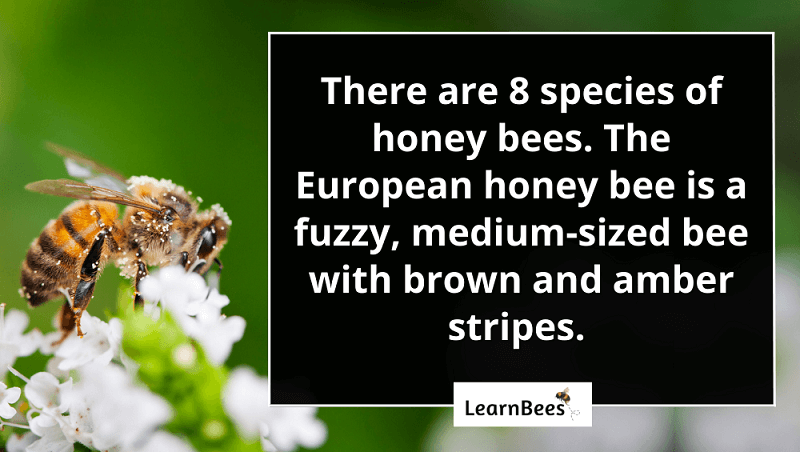
To put it simply:
The European honey bee (Apis mellifera) is the type of honey bee that’s most commonly found in North America. It’s a medium-sized, fuzzy bee with brown and amber stripes.
Honey bees are smaller and less hairy than bumble bees. They live in colonies with thousands of other bees. When you see one honey bee in the garden, you’ll usually spot several others alongside it.
With that in mind:
There are eight different species of honey bees. From there, those eight species are further broken down into 43 subspecies.
For example, the black honey bee (Apis andreniformis) is darker and much smaller than the European honey bee.
And here’s the thing:
There are more than two million honey bee colonies in the United States.
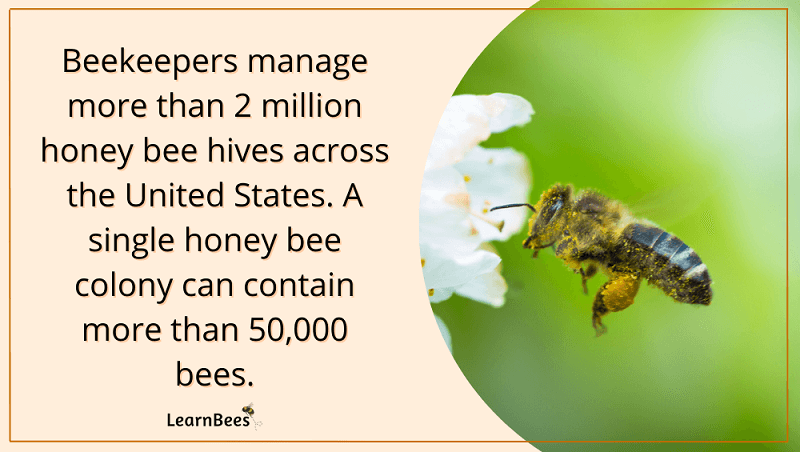
To put that into perspective, a single honey bee colony can contain upwards of 50,000 honey bees. This means that billions of European honey bees fly around the United States alone.(1)
But keep in mind:
Honey bees are sometimes mistaken for yellowjackets.
Yellowjackets and honey bees aren’t the same. Yellowjackets are a type of wasp that lives in social colonies like honey bees. They’re also close in size to honey bees.
But unlike honey bees?
Yellowjackets don’t produce honey.
Yellowjackets also have yellow stripes that are very bright. In contrast, honey bees have more of an amber-toned color.
And if you look closely:
You’ll notice that yellowjackets don’t have fuzzy bodies like honey bees do. Instead, yellowjackets have glossy bodies that are nearly hairless. Yellowjackets are also thinner than honey bees, with tiny waists known as “wasp waists.”
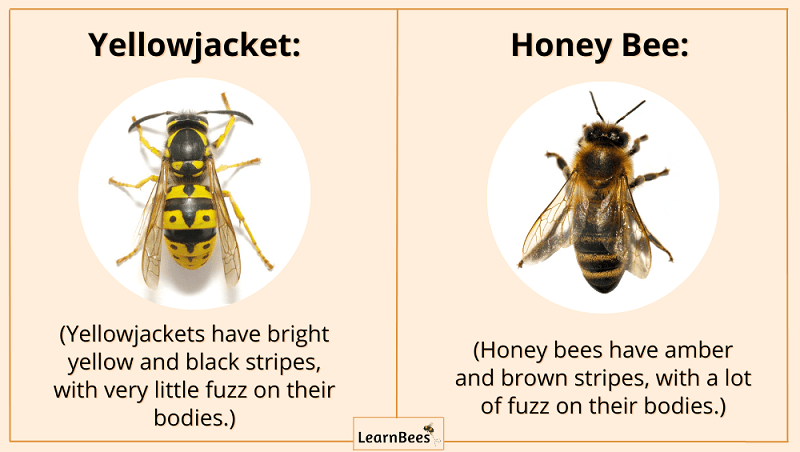
You can also tell the difference between honey bees and wasps by their behavior. Bees, on average, spend much more time foraging on flowers than wasps do.
Now you might be thinking:
What does foraging on flowers mean?
A bee forages when it searches a flower for nectar and pollen. Nectar is a sugary liquid produced by plants. Nectar is like the “energy drink” of the insect world, giving bees the carbohydrates they need to function.
As for pollen?
Pollen provides bees with protein. Unlike wasps, bees don’t eat other insects. Instead, they collect pollen using their fuzzy bodies while gathering nectar from a flower.
But this is a critical behavioral difference between bees and wasps.
Bees tend to spend more time working flowers than wasps do. As such, bees have earned the nickname “busy bees” because they’re laser-focused on collecting food.
Wasps also visit flowers for food, but they don’t tend to forage on them as much as bees do.
How Big Are Honey Bees?
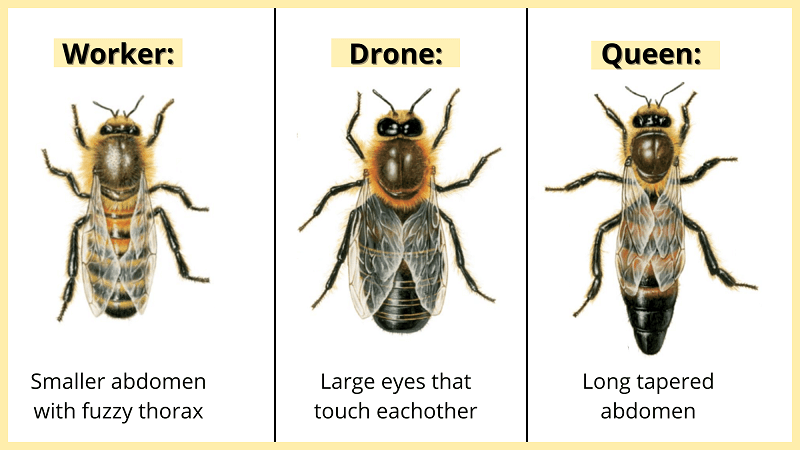
Worker honey bees average between 0.5 and 0.65 inches in length, making them about the size of a dime.
As their name suggests, worker bees do most of the work for the colony. They’re responsible for collecting food and water, so they’re the type of honey bee you’ll most commonly see on flowers.
Interestingly enough?
Worker bees are female bees that make up over 80% of the colony.
They do a lot of heavy lifting, such as feeding, cleaning, and defending the nest. Large numbers of worker honey bees are necessary to maintain the hive. But worker honey bees aren’t the only type of bee in the honey bee hive.
More specifically, there are three types of honey bees:
- Worker honey bees
- Queen honey bees
- Drone honey bees
There is typically only one queen honey bee per hive. Queen bees average 0.8 inches in length, making her about the size of a nickel.
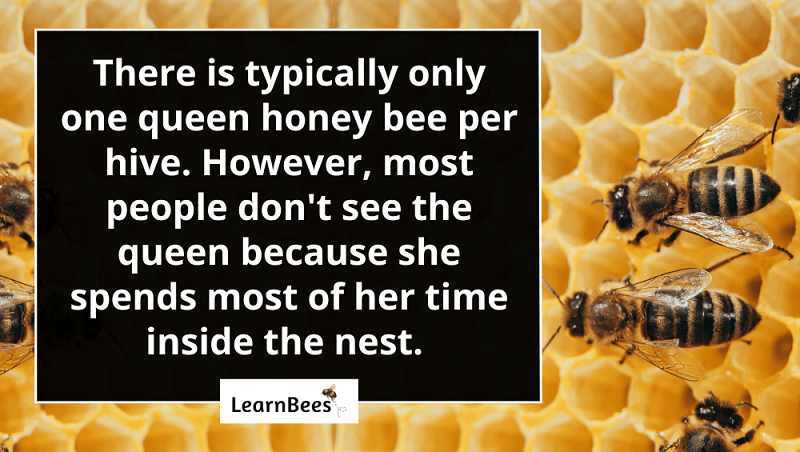
Queen bees lay eggs daily to ensure the future generation of the colony. As such, the queen spends most of her time inside the nest. Her needs are met by the worker bees who feed, groom, and protect her.
What does this mean?
It means that most people never even see queen honey bees. Of course, beekeepers and entomologists (insect scientists) are the exceptions.
And last but not least:
Drone bees are male bees that average between 0.6 and 0.7 inches long.
Drones are responsible for mating with virgin queens from other hives. Sometimes, the slight size differentiation between drones and worker bees isn’t enough to tell them apart.
So, in this case?
You can spot a drone honey bee by looking at its eyes. Drones have large eyes that touch in the middle, while worker bees have smaller eyes that don’t touch.
What’s the Difference Between Honey Bees and Other Bees?

Here’s a fact that might surprise you:
There are more than 20,000 different bee species. Common bee species examples include bumble bees, carpenter bees, mason bees, and of course, honey bees.
For comparison, there are only 6,495 mammal species worldwide.(2)
So, in short?
There are many differences between honey bees and the thousands of other bee species on the planet. There are also a lot of similarities.
That said, there are two notable differences between honey bees and other bees:
1.) Honey bees are one of the only types of bees that produce honey.
Most types of bees are solitary insects that live alone. They hibernate during the winter and don’t produce honey. There are some exceptions to this, but most bees don’t make honey like honey bees.
2.) Honey bees can only sting humans once
Their barbed stingers have “hooks” that get stuck inside the skin. Once the honey bee flies away, its stinger gets left behind, along with other vital organs that get pulled out once they sting.
In contrast, other bee species have smooth stingers that can be used to sting several times.
FAQs on “What Do Honey Bees Look Like?”
- How big are honey bees?
- What does a common honey bee look like?
- How can you tell if it’s a honey bee?
- What wasp looks like a honey bee?
- What looks like a honey bee but isn’t?
- What does a queen honey bee look like?
- What does a drone honey bee look like?
- What does a worker honey bee look like?
How big are honey bees?
The worker honey bee is the most common type in North America. Worker honey bees are about the size of a dime, measuring 0.5 and 0.65 inches in length.
However, two other types of honey bees live in hives: drones and queens.
Drone honey bees are male bees that are slightly bigger than their worker bee counterparts. They measure between 0.6 and 0.7 inches long. There are far fewer male honey bees than female honey bees, so you’re less likely to see a drone.
Queen honey bees are the largest bees inside the honey bee hive. They measure about 0.8 inches in length, making them about the size of a nickel.
Like drone honey bees, queen honey bees are less likely to be seen because there are fewer of them. In fact, most honey bee hives consist of more than 80% worker bees. There is usually only one queen honey bee per hive.
Additionally, the average person rarely sees the queen honey bee because she spends most of her time inside the nest. A strong, healthy queen bee can lay up to 2,000 eggs daily. She’s usually too busy during peak seasons to do anything else – including leaving the hive.
In turn, the queen’s needs are met by the worker honey bees. The workers feed, groom, and protect her 24/7.
—> Go back to the FAQs on “What Do Honey Bees Look Like?”
More to Explore:
What does a common honey bee look like?
There are eight species of honey bees worldwide. These eight species can further be broken down into 43 subspecies. Each subspecies can have slightly different characteristics and habits.
With that in mind, the European honey bee (Apis mellifera) is the most common species in the United States.
European honey bees are mid-sized, hairy bees with brown and amber stripes. Their stripes can appear more yellow in sunlight or under a microscope.
Sometimes honey bees are mistaken for yellowjackets. However, they aren’t the same. Yellowjackets are wasps, not bees.
As their name implies, European honey bees are not native to North America. They were originally imported from Europe in the 1600s.
—> Go back to the FAQs on “What Do Honey Bees Look Like?”
More to Explore:
How can you tell if it’s a honey bee?
The best way to tell honey bees apart from other bees and wasps is to study them. Once you memorize their physical characteristics, they’re pretty easy to identify in gardens.
Honey bees are smaller than bumble bees and less fuzzy. They still have some hairs, though, which helps them gather and carry pollen back to their nest. Additionally, they have brown and amber stripes on their abdomen.
Unlike yellowjackets, honey bees aren’t as brightly colored yellow. They also have thicker bodies with more hair than wasps.
—> Go back to the FAQs on “What Do Honey Bees Look Like?”
More to Explore:
- Honeybees vs. Bumblebees: How Do They Compare?
- What Kind of Bees Make Hives in Trees?
- What Do Killer Bees Look Like?
What wasp looks like a honey bee?
Yellowjackets are a type of wasp that is commonly mistaken for honey bees.
Yellowjackets have bright yellow and black stripes on their abdomen. They also have a thin “wasp waist” that separates their thorax and abdomen.
However, yellowjackets don’t have extra body hair like honey bees. They also spend less time on flowers than bees and are more defensive.
—> Go back to the FAQs on “What Do Honey Bees Look Like?”
More to Explore:
What looks like a honey bee but isn’t?
There are many wasps and flies that resemble honey bees but aren’t. Yellowjackets and hover flies are two types of insects that often get mistaken for honey bees.
—> Go back to the FAQs on “What Do Honey Bees Look Like?”
More to Explore:
What does a queen honey bee look like?
Queen honey bees have brown and amber stripes, with a long tapered abdomen compared to worker honey bees. Queens have longer abdomens for egg storage.
Queen honey bees can grow 0.8 inches or longer, which is about the size of a nickel. The size differentiation is typically noticeable if you place a worker honey bee next to a queen honey bee.
—> Go back to the FAQs on “What Do Honey Bees Look Like?”
More to Explore:
What does a drone honey bee look like?
Drone honey bees are male bees that are slightly smaller than queens and slightly larger than workers. They have fuzzy, amber and brown stripes on their abdomens.
Moreover, drone honey bees can be easily identified by their eyes. Their eyes are larger and more bulbous than worker bees. In fact, their eyes are so large that they touch in the middle.
In contrast, worker honey bees have smaller eyes that don’t meet in the center.
—> Go back to the FAQs on “What Do Honey Bees Look Like?”
More to Explore:
- How Many Eyes Does a Bee Have?
- How Many Wings Does a Bee Have?
- The Best Essential Oils for Bee Stings
What does a worker honey bee look like?
Worker honey bees are the most common type of honey bee that people encounter because more than 80% of the hive consists of them.
Worker honey bees are smaller than queens and drones, with an abdomen that is slightly shorter. They also have an even mix of brown and amber stripes on their abdomens.
Additionally, worker honey bees can be identified by their relatively small eyes that don’t meet in the middle.
